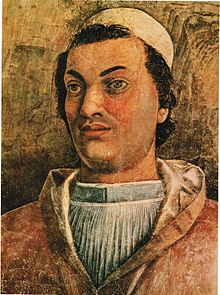Francesco Gonzaga (1444–1483)

Francesco Gonzaga (15 March 1444,
Background
Born in Mantua on 15 March 1444, Francesco Gonzaga was the second son of
After completing his studies at
The Cardinal
Under Pope Pius II
At the request of his cousin,
Under Pope Paul II
Appointed as the 39th
Two years later, on 18 July 1466, the Bishop of Mantua, Galeazzo Cavriani, died and Francesco was appointed a month later, on 20 August, to succeed him. His great grandfather's first cousin, Sagramoso Gonzaga ( 1360 – 1405 ), had been the Bishop of Mantua for four years ( 1386 – 1390 ). But Francesco's own title was the Apostolic Administrator of the Diocese of Mantua. He would keep it until his death[7] but he was never raised to the rank of Bishop. He would be succeeded by five consecutive members of his family. The first two were Apostolic Administrators but the third, Ercole Cardinal Gonzaga, Francesco's grandnephew, was the first to be Bishop.[7]
Francesco participated in the secret
Under Pope Sixtus IV

Francesco then returned to Rome on 4 August of that year to participate in the
In the spring of 1472, Francesco was appointed as the Apostolic Administrator of the Metropolitan See of
Francesco fled from Rome on 10 June 1476 because of the outbreak of the plague at the Papal Court. A month later, on 18 July, the Bishop of Bologna, Filippo Calandrini, died. He was replaced eight days later, on 26 July, by the Cardinal of Mantua as the Apostolic Administrator[8] but, in March 1477, he was still in Rome. He did not go to Bologna for the actual possession until 18 July 1478, two years late. On 20 March 1479, anti-Papal riots erupted in Bologna but Gonzaga was able to restore order. However, he was never made the Bishop of Bologna; that title went after his death to Giuliano Cardinal della Rovere, the future Pope Julius II.[8]
Francesco had already resigned his office of the

From 1479 to 1480 Francesco hosted Angelo Poliziano at his court in Mantua, where the scholar poet wrote the Fabula of Orpheus ( Italian: Fabula di Orfeo ). Like other members of the family,[9] Francesco collected antiquities, including pieces of the treasures that belonged to Pope Paul II, himself a collector of gems.[10]
Besides painting Francesco in the Camera deli Sposi, Andrea Mantegna also did the , Italy.
Death
He died from intoxication on 21 October 1483 at the Palazzo della Signoria in Bologna. In the original document attesting to his death, it was stated that the cause of death was per disordini; percioché bevendo l'acqua della Porretta non servò la guardia conveniente [ Of disorders; because drinking the water of the Porretta, he did not observe the necessary care ].[11] His body was transported to Mantua and buried in the family mausoleum at the Church of San Francesco. The funeral oration was delivered by Giovanni Lucido Cataneo.[12]
See also
- House of Gonzaga
- Andrea Mantegna, Camera degli Sposi
- Andreas Mantegna, Portrait of Francesco Gonzaga ( ca. 1460 )
References
- ^ Lazzarini, "GONZAGA, Francesco", Dizionario Biografico degli Italiani.
- ^ a b Antenhofer 2001, p. 58.
- ^ Mantovani, Il castello di Castel d'Ario, no page given.
- ^ (in English) "Francesco Cardinal Gonzaga †", Catholic Hierarchy, retrieved 21 January 2014.
- ^ The titular church of Santa Maria Nuova was suppressed on 18 August 1661 by Pope Alexander VII, who replaced it with the new Church of Santa Maria della Scala.
- ^ (in English) "Diocese of Bolzano-Bressanone { Bozen-Brixen }", Catholic Hierarchy, retrieved 21 January 2014.
- ^ a b (in English) "Diocese of Mantova", Catholic Hierarchy, retrieved 21 January 2014.
- ^ a b (in English) "Diocese of Bologna", Catholic Hierarchy, retrieved 21 January 2014. The Diocese of Bologna did not become the Archdiocese of Bologna until 1582.
- ^ (in Italian) Francesco Rapaccioni, "Il Cammeo Gonzaga. Arti preziose alla corte di Mantova [ The Gonzaga Room. Precious Arts at the Court of Mantua ]", posted 31 October 2008, Teatro.org : Le Rubriche : Mostre Arte [ Theater.org : Categories : Art Exhibitions ], retrieved 21 January 2014.
- ^ (in Italian) "Il Cammeo Gonzaga. Arti preziose alla corte di Mantova", press release archived online, retrieved 21 January 2014.
- ^ The sulphurous waters of Porretta Terme produces an important healing effect for skin problems, from which the Cardinal probably suffered, but they must be taken with caution because of the minerals contained in the waters.
- ^ This Giovanni Lucido Cataneo ( 1462 – 1505 ), the archdeacon and ambassador from Mantua at the Papal Court, should not be confused with the later Giovanni Lucido Cataneo ( 1613 – 1685 ), the 46th Bishop of Mantua ( 1673 – 1685 ).
Bibliography
- Antenhofer, Christina (2001). "From Local Signori to European High Nobility: The Gonzaga Family Networks in the Fifteenth Century". In Johnson, Christopher H.; Sabean, David Warren; Teuscher, Simon; Trivellato, Francesca (eds.). Transregional and Transnational Families in Europe and Beyond: Experiences. Berghahn books.
- (in Italian) Isabella Lazzarini, "GONZAGA, Francesco", Dizionario Biografico degli Italiani [ Biographical Dictionary of the Italians ] – Volume 57 ( 2002 )
- (in Italian) Gabriella Mantovani, Il castello di Castel d'Ario ( Mantua : Sometti, 2012 ), ISBN 9788874954377
- (in German) Charlotte Zweynert, Ausgleichende Verfügungen, verbindende Gegenstände, konkurrierende Interessen. Das Testament des zweitgeborenen Francesco Gonzaga aus dem Jahr 1483, in: Christine Fertig, Margareth Lanzinger (Hg.), Beziehungen, Vernetzungen, Konflikte. Perspektiven Historischer Verwandtschaftsforschung, Köln, Weimar, Wien 2016, S. 37–65.
External links
- (in English) Salvador Miranda, Biography of Francesco Cardinal Gonzaga Archived 2015-06-30 at the Wayback Machine, "Biographical Dictionary : Pius II ( 1458 – 1464 ), Consistory of December 18, 1461 ( II ), Celebrated in Rome", The Cardinals of the Holy Roman Church
- (in German) Eleonore Gürtler, "Francesco Gonzaga ( 1444 – 1483 ), Kardinal", Kult.Doku : Verborgene Schätz aus Österreichischen Landesausstellungen [ Cult.Docu : Hidden Treasures of the Austrian National Exhibitions ]
